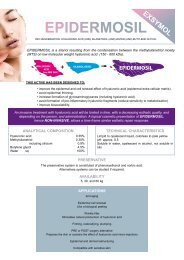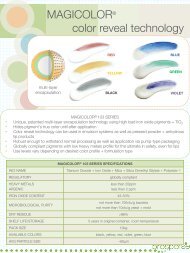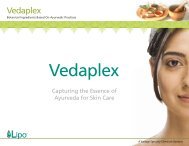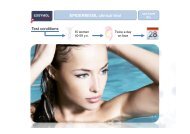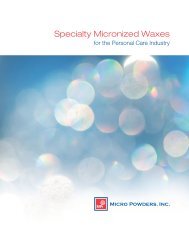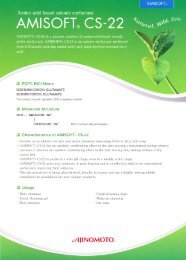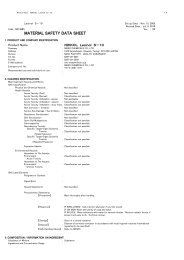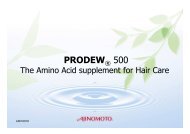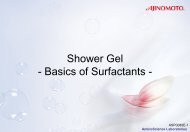You also want an ePaper? Increase the reach of your titles
YUMPU automatically turns print PDFs into web optimized ePapers that Google loves.
<strong>MATRIGENICS.14</strong> G<br />
Re-activates 14 genes to recover<br />
the Triangle of Beauty in 14 days only
Matrigenics.14 G: extract of fertile bases of Undaria<br />
Matrigenics.14 is a concentrate obtained<br />
from the fertile bases of the alga Undaria<br />
pinnatifida.<br />
This fertile bases, also known has<br />
Mekabu contain the spores that are<br />
responsible for the species’ reproduction<br />
and are considered as a life concentrate,<br />
having precious rejuvenation virtues.<br />
Rich in Wakamic ester, a sulfated<br />
galactofucane this life concentrate reactivates<br />
14 genes implicated in the redensification<br />
of the extra-cellular matrix<br />
of the dermis for a rejuvenating effect.<br />
Wakamic ester
Undaria, Spores and Fertile Bases...<br />
Undaria pinnatifida, from the Latin "unda", a<br />
wave, and pinnatififa, feather-shaped, is also<br />
commonly known as “Wakame” in Japan.<br />
It is a brown macro-algae attaining up to 2m.<br />
When mature, the edges of the stipe become<br />
broader and wavy. These new tissues, known<br />
as fertile bases or even Mekabu, contain the<br />
reproductive cells of the alage.<br />
The Undaria reproductive cells are released<br />
into the environment before the adult plant<br />
dies off at the end of the summer. Each<br />
reproductive cell will then germinate into a<br />
new alga, ensuring the reproduction and the<br />
perenn<strong>it</strong>y of the species.<br />
Fertile bases, Mekabu are much appreciated<br />
in Japanese food.<br />
Fertile base, full of<br />
reproductive cells
From Undaria to Matrigenics.14 G<br />
Matrigenics.14 G is an aqueous extract of<br />
fertile bases of Undaria pinnatifida.<br />
In collaboration w<strong>it</strong>h local partners, Codif<br />
R&N cultivates the alga in Br<strong>it</strong>tany (France) in<br />
a protected area of the Rance.<br />
• Culture of the alga:<br />
– In<strong>it</strong>ially collected in the sea<br />
– Placed in hatcheries<br />
– Germination, formation of small alga<br />
– Transfer to the open sea for growth<br />
on a longline system<br />
• Harvest:<br />
– Adult algae are collected 1 year after<br />
– Fertile bases are isolated and used<br />
to produce Matrigenics.14 G<br />
– Other parts of the algae are used for<br />
food applications<br />
Cultivation s<strong>it</strong>e<br />
Hatcheries<br />
<strong>MATRIGENICS.14</strong> G is a natural and<br />
ecofriendly active ingredient.<br />
Longline system
What contributes to the face ageing?<br />
In youth the cheekbones are high and<br />
well defined, and the jaw line is also well<br />
defined, yet soft.<br />
This is called ‘The Triangle of Beauty’.<br />
W<strong>it</strong>h ageing appear wrinkles, but also a<br />
descent of the brow, a loss of elastic<strong>it</strong>y<br />
of the skin (jowls develop), a drooping of<br />
the lip edges…<br />
The ‘Triangle of Beauty’ is lost which is<br />
less attractive and make look<br />
permanently unhappy and sad.
What is the main concern of women in terms<br />
of ageing?<br />
A study realized by Arcane Research<br />
(French Poll) on 4400 women in 2011<br />
reveals that:<br />
29% of women are concerned by the<br />
wrinkles between the eyebrows<br />
32% of women are concerned by the<br />
nasal furrows wrinkles<br />
37% of women are concerned by the<br />
lines and furrows around the mouth
What is the role of the ExtraCellular Matrix in the<br />
formation of lines, furrows and wrinkles?<br />
DÉRÈGLEMENT DES ADIPOCYTES ET DES FIBROBLASTES :<br />
UNE ORIGINE GÉNÉTIQUE<br />
The Extracellular Matrix (ECM) is the largest<br />
component of normal skin and gives the skin<br />
<strong>it</strong>s unique properties of elastic<strong>it</strong>y, tensile<br />
strength and compressibil<strong>it</strong>y.<br />
These properties are due to the combination<br />
of two main classes of molecules, which are<br />
secreted by fibroblasts and epidermal cells:<br />
• structural proteins: collagens, elastin<br />
• proteoglycans: like hyaluronic acid, which<br />
are large and highly hydrated.<br />
These molecules are assembled and<br />
organized in a specific way into the<br />
Extracellular Matrix in order to ensure the<br />
structural integr<strong>it</strong>y of the skin
What is the role of the ExtraCellular Matrix in the<br />
formation of lines, furrows and wrinkles?<br />
DÉRÈGLEMENT DES ADIPOCYTES ET DES FIBROBLASTES :<br />
UNE ORIGINE GÉNÉTIQUE<br />
The appar<strong>it</strong>ion of lines, furrows and wrinkles<br />
is due to a disorganisation of the ECM directly<br />
linked to the quant<strong>it</strong>y and the qual<strong>it</strong>y of <strong>it</strong>s<br />
main components: collagen, elastin and<br />
proteoglycan.<br />
The synthesis of these molecules is regulated<br />
by our genes. A gene is a code which orders<br />
the manufacture of a specific protein.<br />
W<strong>it</strong>h age, genes are less active and the<br />
quant<strong>it</strong>y and qual<strong>it</strong>y of protein synthesised is<br />
lower.<br />
The solution: awaking the activ<strong>it</strong>y of genes<br />
responsible for the synthesis of the<br />
components of the ECM.
Action mechanism of Matrigenics.14 G<br />
Goal:<br />
Re-building the Extracellular Matrix (ECM)<br />
Action mechanism:<br />
Re-activation of 14 genes implicated in the<br />
synthesis, the maturation, the assembling<br />
and the anchoring of collagen, elastin and<br />
hyaluronic acid<br />
Forehead wrinkles<br />
Results:<br />
Decrease of forehead wrinkles<br />
Decrease of nasal furrows<br />
Decrease of lines around the lips<br />
Nasal<br />
furrows<br />
Mouth<br />
wrinkles
In-V<strong>it</strong>ro Test: 2% Matrigenics.14 G stimulates genes implicated in<br />
collagen synthesis, maturation and anchoring.<br />
(2% Matrigenics.14 G, Human Dermal Fibroblasts, Minichips)<br />
Genes involved in the synthesis of collagen fibres<br />
Fibroblast<br />
+15% COL I (Collagen I)<br />
+ 20% COL IV (Collagen IV)<br />
+37% COL VIII (Collagen VIII)<br />
Genes involved in the maturation of collagen fibres<br />
+61% P4HA1 (Proline Hydrolase 1)<br />
+30% P4HA2 (Proline Hydrolase 2)<br />
Genes involved in the assembling of collagen fibres<br />
+50% LOX (Lysyl oxydase)<br />
+43% LOXL2 (Lysyl oxydase L2)<br />
Genes involved in the anchoring of collagen fibres<br />
SYNTHESIS &<br />
MATURATION<br />
ASSEMBLING<br />
ANCHORING<br />
COLs<br />
P4HA1<br />
P4HA2<br />
LOX<br />
LOXL2<br />
LUMICANE<br />
DECORINE<br />
+72% LUMICANE<br />
+23% DECORINE<br />
Dermis Epidermis
In-V<strong>it</strong>ro Test : Illustration of the Collagen I booster effect of<br />
2% Matrigenics.14 G<br />
Method: Human Dermal Fibroblasts incubated w<strong>it</strong>h 2% Matrigenics.14 G for 48 hours. Observation of collagen<br />
fibres using immunolabelling<br />
W<strong>it</strong>hout Matrigenics.14 G<br />
Low level of intracellular labelling,<br />
collagen fibres are immature and not assembled<br />
W<strong>it</strong>h Matrigenics.14 G<br />
High level of extracellular labelling,<br />
collagen fibres are mature and assembled
In-V<strong>it</strong>ro Test: 2% Matrigenics.14 G stimulates genes implicated in<br />
elastin synthesis, maturation and anchoring.<br />
(2% Matrigenics.14 G, Human Dermal Fibroblasts, Minichips)<br />
Fibroblast<br />
Genes involved in the synthesis of elastin fibres<br />
+ 21% ELAST (Elastin)<br />
Genes involved in the maturation of elastin fibres<br />
+36% FBN1 (Fibrilline 1)<br />
Genes involved in the assembling of elastin fibres<br />
+50% LOX (Lysyl oxydase)<br />
+43% LOXL2 (Lysyl oxydase L2)<br />
SYNTHESIS &<br />
MATURATION<br />
ASSEMBLING<br />
ELAST<br />
FBN1<br />
LOX<br />
LOXL2<br />
Genes involved in the strengthening and protection of<br />
elastin fibres<br />
+18% TIMP2 (Tissue Inhib<strong>it</strong>or MetalloProteinase 2)<br />
Dermis Epidermis
In-V<strong>it</strong>ro Test : Illustration of the Elastin booster effect of<br />
2% Matrigenics.14 G<br />
Method: Human Dermal Fibroblasts incubated w<strong>it</strong>h 2% Matrigenics.14 G for 48 hours. Observation of<br />
(Tropo)Elastin fibres using immunolabelling<br />
W<strong>it</strong>hout Matrigenics.14 G<br />
Low level of intracellular labelling,<br />
elastin fibres are immature and not assembled<br />
W<strong>it</strong>h Matrigenics.14 G<br />
High level of extracellular labelling,<br />
elastin fibres are mature and assembled
In-V<strong>it</strong>ro Test: 2% Matrigenics.14 G stimulates gene implicated in<br />
Hyaluronic acid synthesis and fibroblast mobil<strong>it</strong>y<br />
(2% Matrigenics.14 G, Human Dermal Fibroblasts, Minichips)<br />
Genes implicated in the synthesis of Hyaluronic acid<br />
+68% HAS (Hyaluronic Acid Synthase)<br />
Genes implicated in the mobil<strong>it</strong>y of fibroblasts<br />
+31% CD44 (Cluster of Differentiation 44)<br />
Hyaluronic acid<br />
CD44<br />
Fibroblast<br />
HAS<br />
Glucuronic acid + N-<br />
acetyl-glucosamin<br />
CD44 is a transmembraneous proteins which helps<br />
to maintain a balance between Hyaluronic acid<br />
synthesis and degradation into the matrix. In<br />
add<strong>it</strong>ion, via CD44, fibroblasts binds hyaluronic acid<br />
to migrate into the dermis, thus ensuring an<br />
homogenous repart<strong>it</strong>ion of cells and fibres in this<br />
layer.<br />
Dermis Epidermis
Conclusion on In-V<strong>it</strong>ro tests<br />
Matrigenics.14 G re-activates 14 genes<br />
Genes linked<br />
to collagen<br />
Genes linked<br />
to elastin<br />
COL1<br />
ELAST<br />
COL2<br />
COL8<br />
P4HA1<br />
P4HA2<br />
LUM<br />
DCN<br />
Genes linked<br />
to collagen &<br />
elastin<br />
FBN1<br />
TIMP2<br />
Genes linked<br />
to hyaluronic<br />
acid<br />
HS<br />
CD44<br />
to restructure the ExtraCellular Matrix<br />
Dermis Epidermis<br />
LOX<br />
LOXL2
Clinical studies<br />
PROTOCOLE<br />
Application:<br />
• Cream containing 2% Matrigenics.14 G<br />
applied twice daily for 14 and 28 days versus<br />
placebo<br />
• 2 groups of 22 volunteers<br />
• Age: 50-65 years<br />
Analysis:<br />
• At T0, T14 days, T28 days<br />
• Analysis of forehead wrinkles, nasal furrows<br />
mouth wrinkles<br />
• Method: innovative analytic method of fringe<br />
projection in 3D.
In-Vivo test: effect on wrinkles and lines of the forehead<br />
2% Matrigenics.14.G<br />
Matrigenics.14 G sigificantly decreases<br />
the lines and wrinkles of the forehead<br />
after 14 days of treatment.<br />
Average and significant decreases :<br />
-23.8%* of the volume of wrinkles<br />
-14.4%* of the area of wrinkles<br />
A prolongation of the treatment to 28<br />
days does not induce a siginificant<br />
variation of volume and area of wrinkles,<br />
compared to D14.<br />
Average variation versus placebo (in %)<br />
0<br />
-5<br />
-10<br />
-15<br />
-20<br />
-25<br />
Volume of wrinkles<br />
-23,8%*<br />
Area of Wrinkle<br />
-14,4%*<br />
*p
In-Vivo test: effect on wrinkles and lines of the forehead<br />
2% Matrigenics.14.G<br />
Visible effect after 14 days of treatment<br />
Before treatment<br />
After 14 days treatment
In-Vivo test: effect on nasal furrows and mouth wrinkles<br />
2% Matrigenics.14.G<br />
Matrigenics.14 G decreases nasal<br />
furrows and mouth wrinklesafter 14 days<br />
of treatment.<br />
Results are improved by prolonging the<br />
treatment to 28 days:<br />
Nasal furrows<br />
-8% of the volume<br />
-9% of the area<br />
Mouth wrinkles<br />
-18% of the volume<br />
-16% of the area<br />
Average variation versus placebo (in %)<br />
0<br />
-2<br />
-4<br />
-6<br />
-8<br />
-10<br />
-12<br />
-14<br />
-16<br />
-18<br />
-20<br />
Nasal furrows<br />
Mouth wrinkles<br />
Volume Area Volume Area<br />
-2%<br />
-3%<br />
-4%<br />
-6%<br />
-8%<br />
-9%<br />
-16%<br />
-18%<br />
14 days 28 days
In-Vivo test: 2% Matrigenics.14.G<br />
Visualisation of the anti-wrinkle effect on the nasal furrows and<br />
mouth wrinkle<br />
Visible effect after 14 days of treatment<br />
Before treatment<br />
After 14 days of treatment<br />
Nasal furrows and mouth wrinkles are visibly reduced
In-Vivo test: 2% Matrigenics.14.G<br />
Visualisation of the global anti-aging effect<br />
Both depth and length of nasal<br />
furrows are visibly reduced<br />
Before<br />
After<br />
Before<br />
After<br />
The forehead is smoother and the<br />
negative expression of the mouth<br />
is soften
Conclusion on Matrigenics.14 G<br />
Concentrate of fertile bases of the alga Undaria pinnatifida<br />
Rich in Wakamic ester<br />
Cosmetic Effects<br />
Re-activation of 14 genes implicated in:<br />
- collagen synthesis and anchoring<br />
- elastin synthesis and anchoring<br />
- hyaluronic acid synthesis and fibroblasts mobil<strong>it</strong>y<br />
Clinical results after 14 days only on:<br />
- volume and area of the wrinkles between the<br />
eyebrows<br />
- volume and area of the nasal furrows<br />
- volume and area of the mouth wrinkles<br />
Fights against the inversion of the Triangle of Beauty<br />
INCI Name (compliant w<strong>it</strong>h Chinese regulation)<br />
Glycerin (and) Water (and) Undaria pinnatifida extract<br />
Recommended use: 2%




